Multi-Objective Optimal Scheduling Model of Dynamic Control of Flood Limit Water Level for Cascade Reservoirs
Abstract
1. Introduction
2. Multi-Objective Optimal Scheduling Model of DC-FLWL for Cascade Reservoirs
2.1. Initialization Module
2.2. Optimal Scheduling Module
2.2.1. Objective Function
2.2.2. Constraints
2.3. Dynamic Control Programming Module
2.3.1. Normal Operation Submodule
2.3.2. Adaptive Grading Pre-Release Submodule
2.3.3. Flood Control Operation Submodule
2.3.4. Flood Retention and Refill Submodule
3. Non-Dominated Sorting Culture Differential Evolution (NSCDE) Algorithm
4. Case Study
4.1. Hanjiang Basin Overview
4.2. Scheduling Period and Usage Data
4.3. Parameter Settings of NSCDE Algorithm
5. Results and Discussion
6. Conclusions
Author Contributions
Funding
Acknowledgments
Conflicts of Interest
Abbreviations and Nomenclature
| FLWL | flood limited water level. |
| SC-FLWL | static control of flood limited water level. |
| SC-AFLWL | static control of annual flood limited water level. |
| SC-SFLWL | static control of seasonal flood limited water level. |
| DC-FLWL | dynamic control of flood limited water level. |
| NSCDE | non-dominated sorting culture differential evolution algorithm. |
| MOPs | multi-objective optimization problems. |
| CA | culture algorithm. |
| NSGA-II | non-dominated sorting genetic algorithms II. |
| DE | differential evolution algorithm. |
| SPEA2 | strength pareto evolutionary algorithm 2. |
| PG | power generation. |
| ERR | extreme risk rate. |
| SW | spilled water. |
| WRUR | water resource utilization rate. |
References
- Gleick, P.H. Water and conflict: Fresh water resources and international security. Int. Secur. 1993, 18, 79–112. [Google Scholar] [CrossRef]
- Loucks, D.P.; Van Beek, E. Water Resource Systems Planning and Management: An Introduction to Methods, Models, and Applications; Springer: Ithaca, NY, USA, 2017. [Google Scholar]
- Guo, S.L.; Zhang, H.G.; Chen, H.; Peng, D.Z.; Liu, P.; Pang, B. A reservoir flood forecasting and control system in China. Hydrol. Sci. J. 2004, 49, 959–972. [Google Scholar] [CrossRef]
- Wei, C. A real-time optimization model for flood control. American Geophysical Union, Fall Meeting Abstracts. H21A-1319. 2005. Available online: http://adsabs.harvard.edu/abs/2005AGUFM.H21A1319W (accessed on 4 September 2019).
- Chou, F.N.F.; Wu, C.W. Expected shortage based pre-release strategy for reservoir flood control. J. Hydrol. 2013, 497, 1–14. [Google Scholar] [CrossRef]
- Labadie, J.W. Optimal operation of multireservoir systems: State-of-the-art review. J. Water Resour. Plann. Manag. 2004, 130, 93–111. [Google Scholar] [CrossRef]
- Ahmed, J.A.; Sarma, A.K. Genetic algorithm for optimal operating policy of a multipurpose reservoir. Water Resour. Manag. 2005, 19, 145–161. [Google Scholar] [CrossRef]
- Eum, H.I.; Vasan., A.; Simonovic, S.P. Integrated reservoir management system for flood risk assessment under climate change. Water Resour. Manag. 2012, 26, 3785–3802. [Google Scholar] [CrossRef]
- Ostadrahimi, L.; Mariño, M.A.; Afshar, A. Multi-reservoir operation rules: Multiswarm PSO-based optimization approach. Water Resour. Manag. 2012, 26, 407–427. [Google Scholar] [CrossRef]
- Zhou, Y.L.; Guo, S.L. Incorporating ecological requirement into multipurpose reservoir operating rule curves for adaptation to climate change. J. Hydrol. 2013, 498, 153–164. [Google Scholar] [CrossRef]
- Jain, S.K.; Yoganarasimhan, G.N.; Seth, S.M. A risk-based approach for flood control operation of a multipurpose reservoir. Water Resour. Bull. 1992, 28, 1037–1043. [Google Scholar] [CrossRef]
- Ding, W.; Zhang, C.; Peng, Y.; Zeng, R.; Zhou, H.; Cai, X. An analytical framework for flood water conservation considering forecast uncertainty and acceptable risk. Water Resour. Res. 2015, 51, 4702–4726. [Google Scholar] [CrossRef]
- Cheng, C.T.; Wang, W.C.; Xu, D.M.; Chau, K.W. Optimizing hydropower reservoir operation using hybrid genetic algorithm and chaos. Water Resour. Manag. 2008, 22, 895–909. [Google Scholar] [CrossRef]
- Diao, Y.; Wang, B. Scheme optimum selection for dynamic control of reservoir limited water level. Sci. China Ser. E: Technol. Sci. 2011, 54, 2605. [Google Scholar] [CrossRef]
- Chen, J.H.; Guo, S.L.; Li, Y.; Liu, P.; Zhou, Y.L. Joint operation and dynamic control of flood limiting water levels for cascade reservoirs. Water Resour. Manag. 2013, 27, 749–763. [Google Scholar] [CrossRef]
- Liu, P.; Guo, S.; Li, W. Optimal design of seasonal flood control water levels for the Three Gorges Reservoir. IAHS Publ. Ser. Proc. Rep. 2008, 319, 270–280. [Google Scholar]
- Yun, R.; Singh, V.P. Multiple duration limited water level and dynamic limited water level for flood control with implication on water supply. J. Hydrol. 2008, 354, 160–170. [Google Scholar] [CrossRef]
- Li, X.; Guo, S.L.; Liu, P.; Chen, G.Y. Dynamic control of flood limited water level for reservoir operation by considering inflow uncertainty. J. Hydrol. 2010, 391, 124–132. [Google Scholar] [CrossRef]
- Zhou, Y.; Guo, S.; Liu, P.; Xu, C. Joint operation and dynamic control of flood limiting water levels for mixed cascade reservoir systems. J. Hydrol. 2014, 519, 248–257. [Google Scholar] [CrossRef]
- Meng, X.L.; Liang, X.J.; Yan, B.Z.; Li, W.; Guo, L.H.; Feng, B. Optimizing schemes on dynamic control of reservoir normal elevation in flood season. Nat. Hazard. 2016, 81, 1161–1175. [Google Scholar] [CrossRef]
- Yin, X.L.; Cheng, L.G.; Wang, X.; Lu, J.; Qin, H. Optimization for Hydro-Photovoltaic-Wind Power Generation System Based on Modified Version of Multi-Objective Whale Optimization Algorithm. Energy Procedia. 2019, 158, 6208–6216. [Google Scholar] [CrossRef]
- Liu, Y.; Qin, H.; Mo, L.; Wang, Y.; Chen, D.; Pang, S.; Yin, X. Hierarchical Flood Operation Rules Optimization Using Multi-Objective Cultured Evolutionary Algorithm Based on Decomposition. Water Resour. Manag. 2019, 33, 337–354. [Google Scholar] [CrossRef]
- Liu, Y.; Qin, H.; Zhang, Z.; Yao, L.; Wang, C.; Mo, L.; Ouyang, S.; Li, J. A Region Search Evolutionary Algorithm for Many-Objective Optimization. Inf. Sci. 2019, 488, 19–40. [Google Scholar] [CrossRef]
- Deb, K.; Pratap, A.; Agarwal, S.; Meyarivan, T.A.M.T. A fast and elitist multiobjective genetic algorithm: NSGA-II. IEEE Trans. Evol. Comput. 2002, 6, 182–197. [Google Scholar] [CrossRef]
- Storn, R.; Price, K. Differential evolution—A simple and efficient heuristic for global optimization over continuous spaces. J. Global Optim. 1997, 11, 341–359. [Google Scholar] [CrossRef]
- Zitzler, E.; Laumanns, M.; Thiele, L. SPEA2: Improving the strength Pareto evolutionary algorithm. TIK-report. 2001, p. 103. Available online: https://www.research-collection.ethz.ch/bitstream/handle/20.500.11850/145755/eth-24689-01.pdfhttp://adsabs.harvard.edu/abs/2005AGUFM.H21A1319W (accessed on 4 September 2019).
- Changjiang Water Resources Commission. China Rivers and Lakes (Volume of Yangtze River); China Water Power Press: Beijing, China, 2010. [Google Scholar]
- Changjiang Water Resources Commission. Management of Danjiangkou Hydro Project. Handbook of Danjiangkou Reservoir Operation; China Water Power Press: Wuhan, China, 2012. [Google Scholar]
- Guan, G.M.; Chen, S.J.; Rao, G.H. Hanjiang Basin Planning. Hubei Hydropower. 2006, 3, 9–12. [Google Scholar]
- Duan, W.X. Study on operation and influence of controlled reservoirs in the Hanjiang Basin. Ph.D. Thesis, Wuhan University, Wuhan, China, 2017. [Google Scholar]
- Liu, Y.; Ye, L.; Qin, H.; Hong, X.; Ye, J.; Yin, X. Monthly streamflow forecasting based on hidden Markov model and Gaussian Mixture Regression. J. Hydrol. 2018, 561, 146–159. [Google Scholar] [CrossRef]
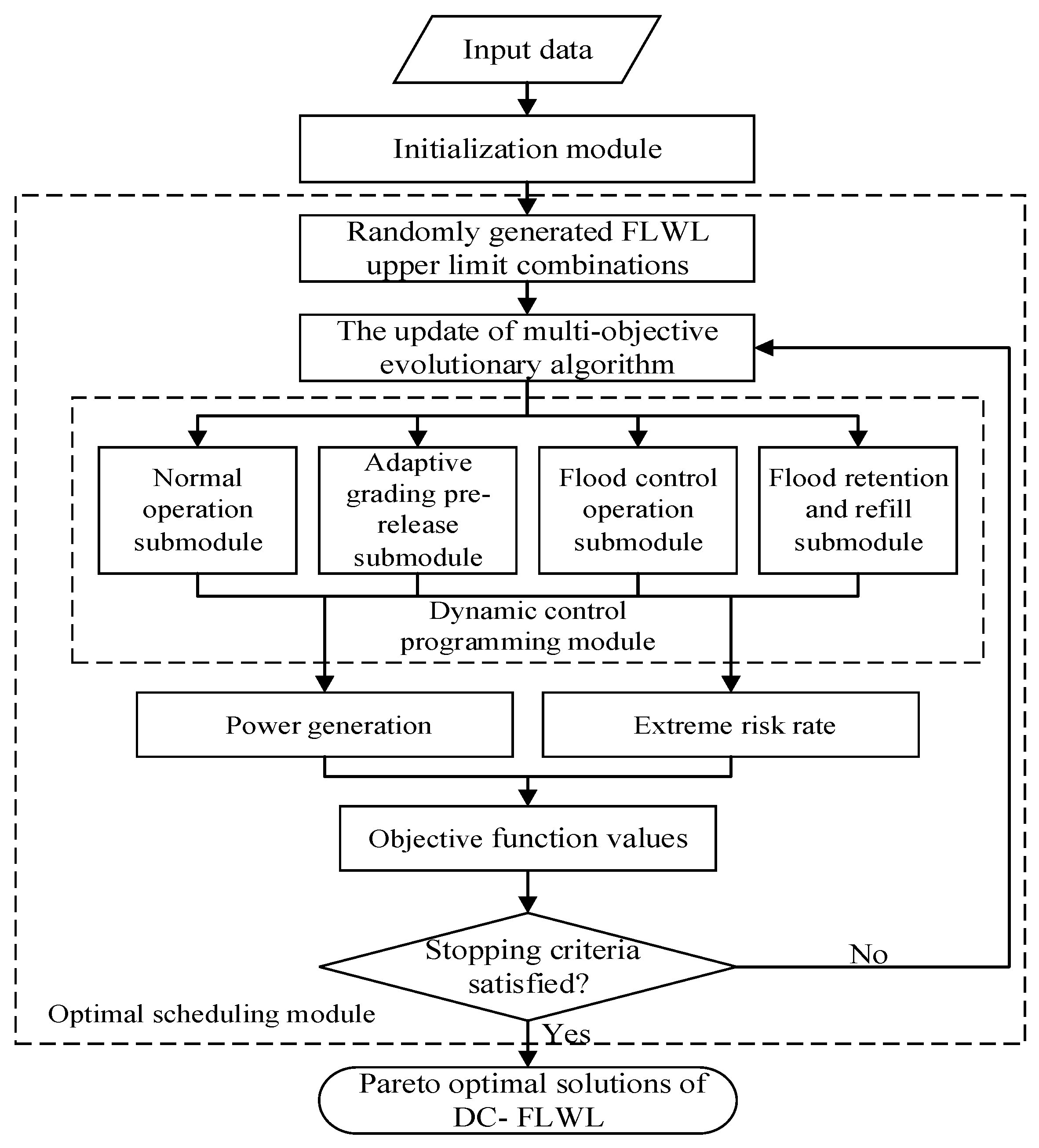
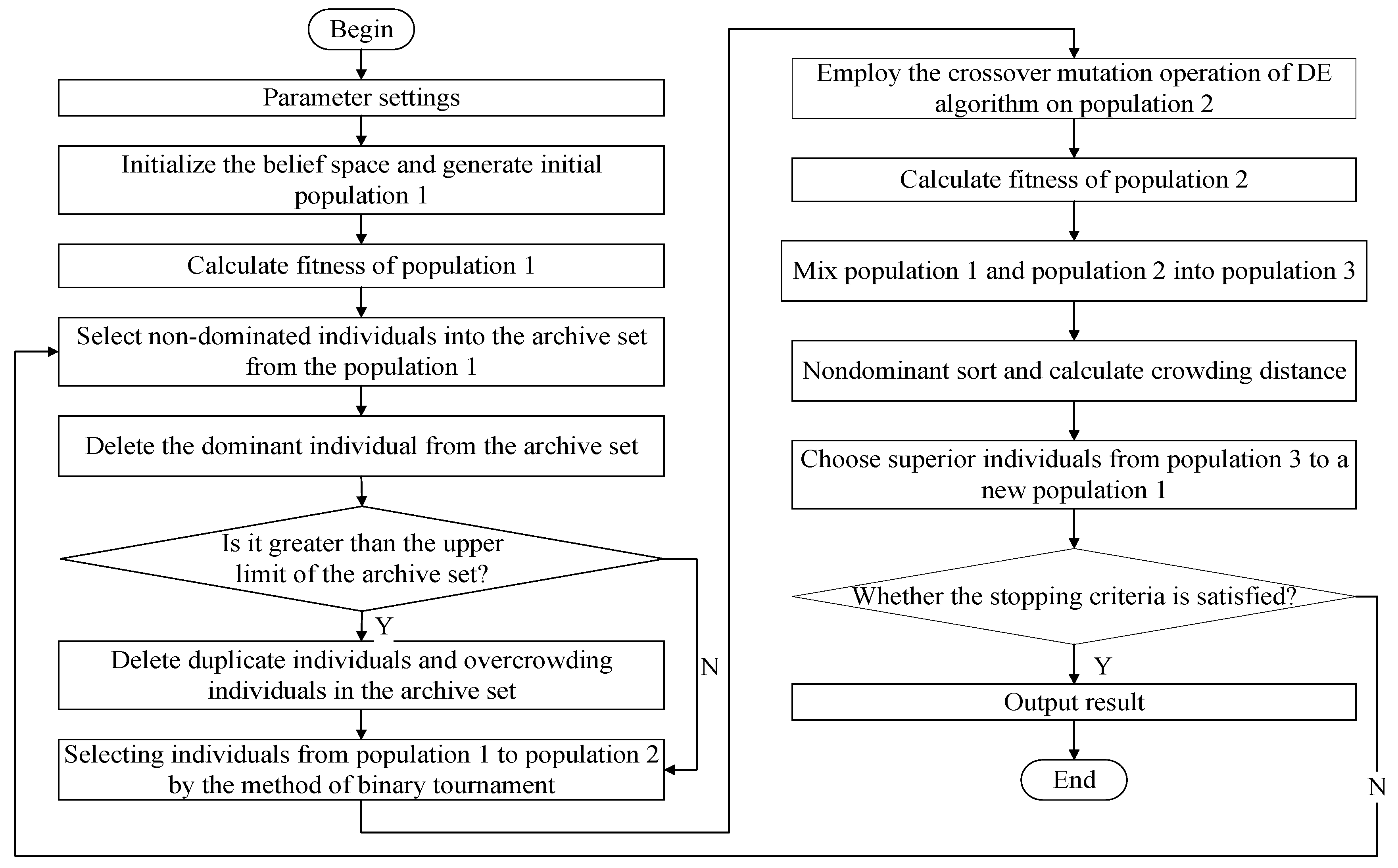
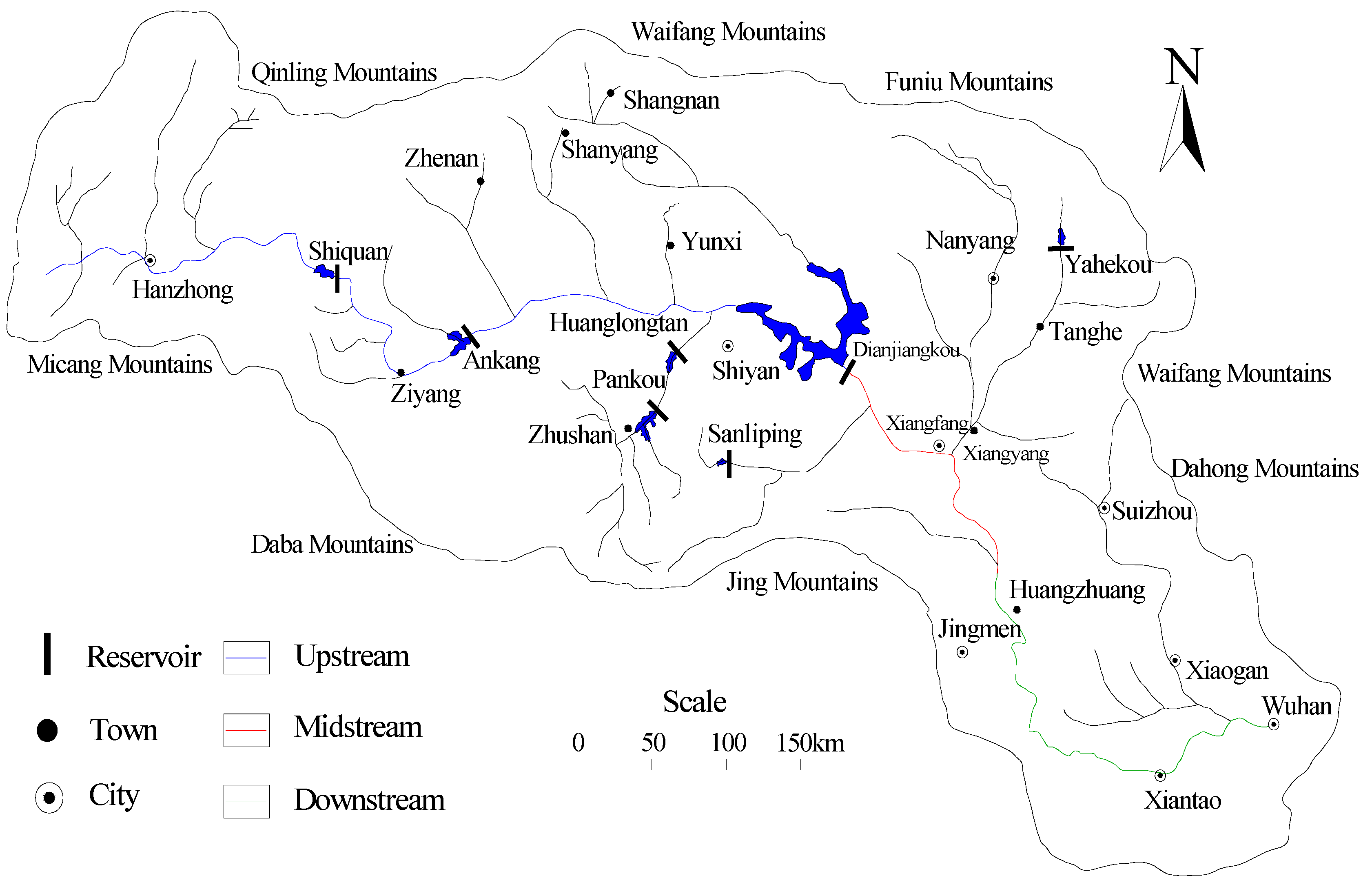
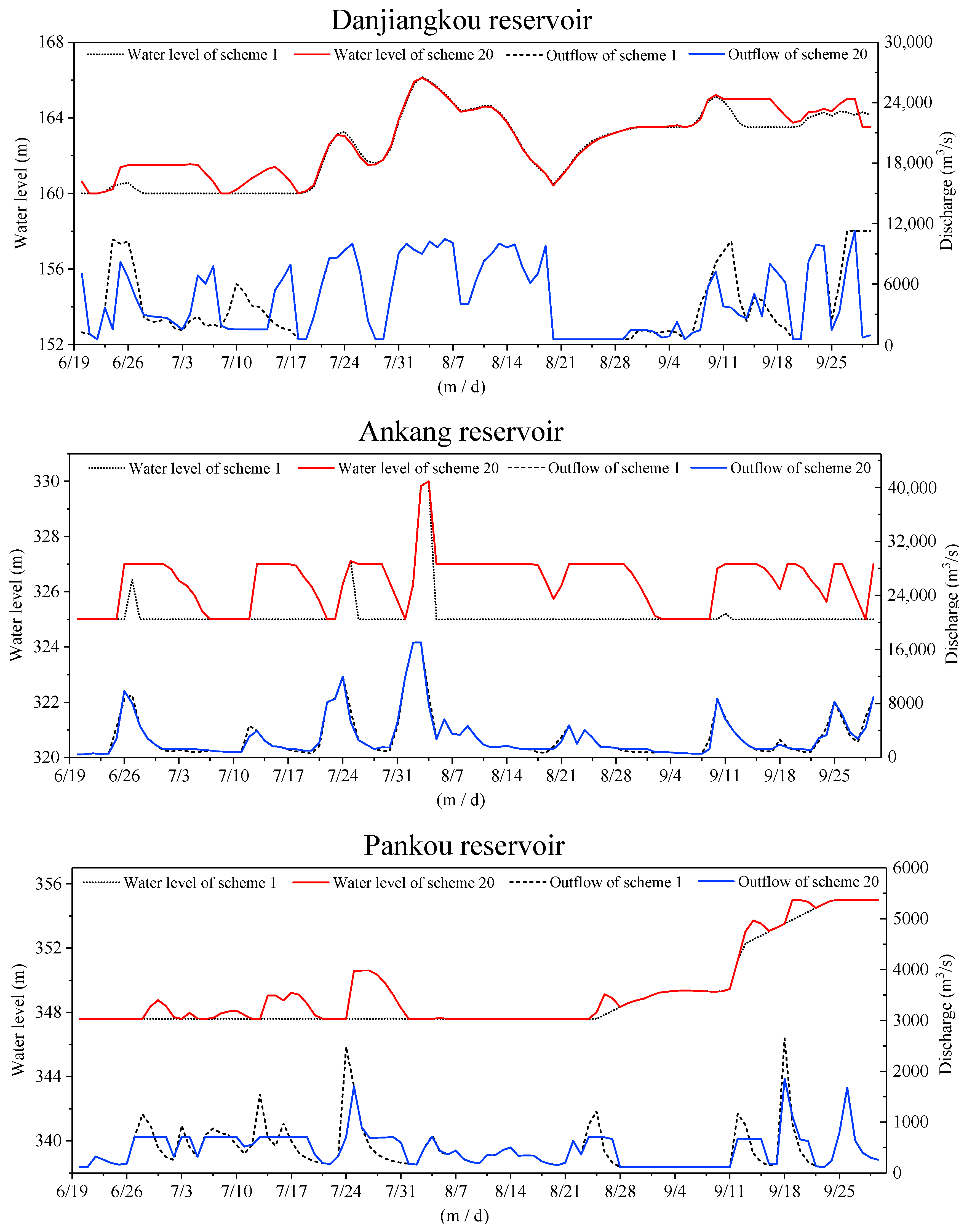

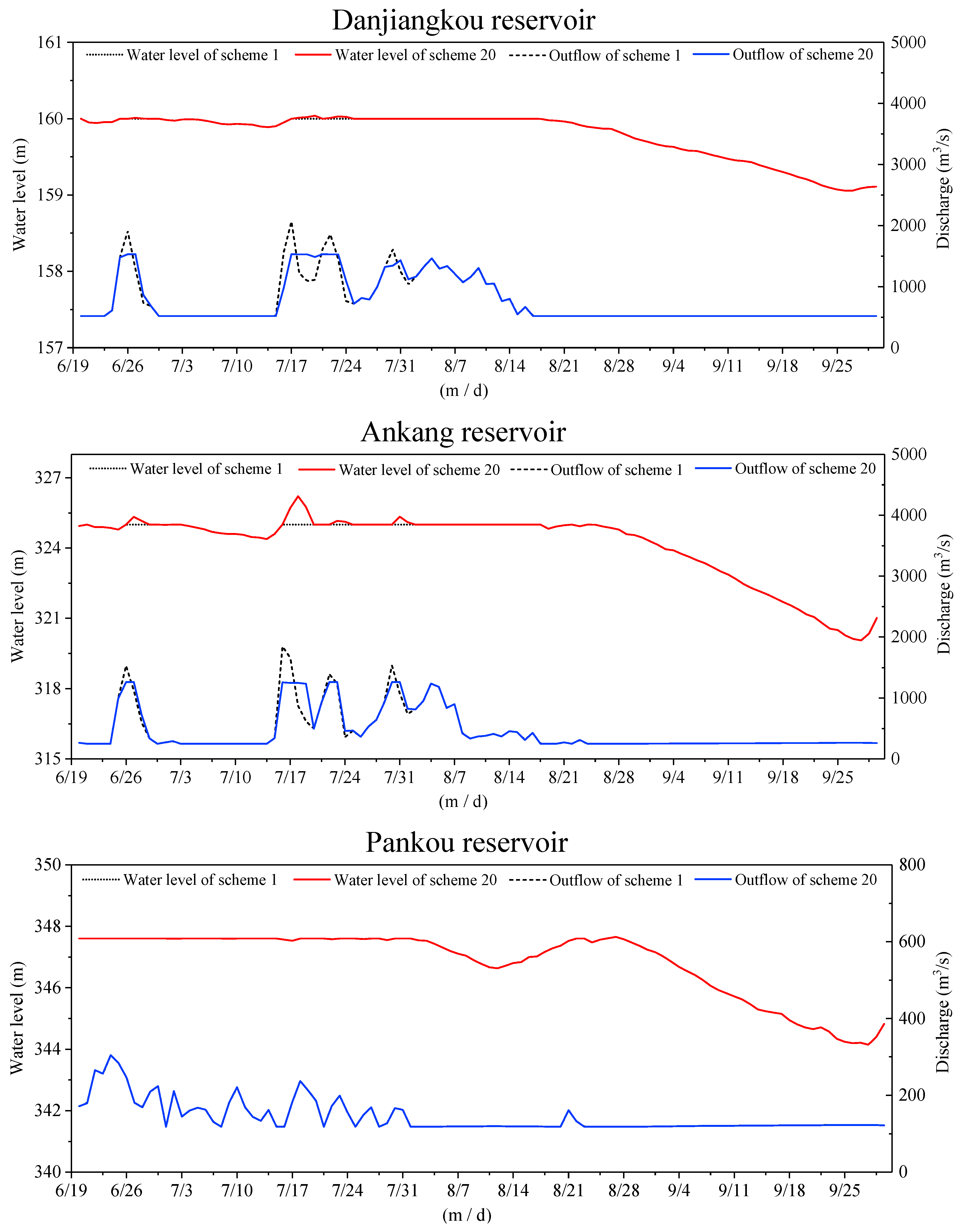
| Reservoir | Normal Water Level (m) | Dead Water Level (m) | FLWL (m) | Installed Capacity (MW) | Design Standards (%) | Flood Storage Capacity (108 m3) |
|---|---|---|---|---|---|---|
| Shiquan | 410 | 400 | 405 | 225 | 1 | 0.98 |
| Ankang | 330 | 305 | 325 | 852.5 | 0.1 | 3.6 |
| Pankou | 355 | 330 | 347.6 | 513 | 0.1 | 4 |
| Huanglongtan | 247 | 222 | 247 | 490 | 1 | 0 |
| Danjiangkou | 170 | 150 | 160(S), 163.5(A) | 900 | 0.1 | 118(S), 81.2(A) |
| Yahekou | 177 | 160 | 175.5(S), 177(A) | 14 | 0.1 | 3.4(S), 0(A) |
| Sanliping | 416 | 392 | 403(S), 412(A) | 70 | 0.2 | 1.21(S), 0.41(A) |
| Reservoir | Ankang | Pankou | Danjiangkou (S) | Danjiangkou (A) |
|---|---|---|---|---|
| Lower limit of FLWL (m) | 325 | 347.6 | 160 | 163.5 |
| Upper limit of FLWL (m) | 327 | 350.6 | 161.5 | 165 |
| Scheme | Power Generation (108 kW·h) | Extreme Risk Rate (%) | The Upper Limit of FLWL (m) | |||
|---|---|---|---|---|---|---|
| Ankang | Pankou | Danjiangkou (S) | Danjiangkou (A) | |||
| 1 | 44.702 | 0.100 | 325.00 | 347.60 | 160.00 | 163.50 |
| 2 | 45.041 | 0.103 | 325.00 | 347.60 | 160.23 | 163.50 |
| 3 | 45.182 | 0.105 | 325.13 | 347.74 | 160.18 | 163.50 |
| 4 | 45.473 | 0.110 | 325.05 | 348.20 | 160.20 | 163.56 |
| 5 | 45.679 | 0.113 | 325.26 | 347.71 | 160.83 | 163.51 |
| 6 | 45.900 | 0.117 | 325.25 | 348.10 | 160.80 | 163.50 |
| 7 | 46.094 | 0.121 | 325.24 | 348.19 | 161.03 | 163.50 |
| 8 | 46.228 | 0.124 | 325.29 | 348.22 | 161.19 | 163.56 |
| 9 | 46.357 | 0.128 | 325.40 | 348.24 | 161.29 | 163.50 |
| 10 | 46.534 | 0.134 | 325.65 | 348.24 | 161.31 | 163.50 |
| 11 | 46.676 | 0.139 | 325.73 | 348.41 | 161.31 | 163.50 |
| 12 | 46.798 | 0.144 | 325.95 | 348.41 | 161.31 | 163.50 |
| 13 | 46.956 | 0.151 | 326.22 | 348.46 | 161.29 | 163.50 |
| 14 | 47.113 | 0.159 | 326.19 | 348.84 | 161.29 | 163.51 |
| 15 | 47.229 | 0.168 | 326.48 | 348.82 | 161.26 | 163.51 |
| 16 | 47.399 | 0.183 | 326.77 | 349.07 | 161.26 | 163.51 |
| 17 | 47.588 | 0.204 | 327.00 | 349.51 | 161.22 | 163.53 |
| 18 | 47.772 | 0.236 | 327.00 | 350.34 | 161.17 | 163.57 |
| 19 | 47.814 | 0.247 | 327.00 | 350.60 | 161.21 | 163.53 |
| 20 | 47.860 | 0.268 | 327.00 | 350.60 | 161.50 | 165.00 |
| Reservoir | PG of Wet Year (108 kW·h) | PG of Normal Year (108 kW·h) | PG of Dry Year (108 kW·h) | Average PG (108 kW·h) | ERR (%) | |
|---|---|---|---|---|---|---|
| Danjiangkou | Scheme 1 | 19.74 | 15.72 | 11.18 | 15.55 | 0.100 |
| Scheme 20 | 20.14 | 17.95 | 11.41 | 16.50 | 0.205 | |
| Difference | 0.40 | 2.22 | 0.23 | 0.95 | 0.105 | |
| Rate | 2.02% | 14.15% | 2.06% | 6.08% | 105.00% | |
| Ankang | Scheme 1 | 18.87 | 14.77 | 7.23 | 13.62 | 0.100 |
| Scheme 20 | 20.18 | 15.88 | 7.88 | 14.64 | 0.250 | |
| Difference | 1.31 | 1.11 | 0.65 | 1.02 | 0.150 | |
| Rate | 6.97% | 7.51% | 8.94% | 7.80% | 150.00% | |
| Pankou | Scheme 1 | 6.88 | 5.11 | 2.68 | 4.89 | 0.100 |
| Scheme 20 | 8.05 | 5.96 | 2.68 | 5.56 | 0.348 | |
| Difference | 1.18 | 0.84 | 0.00 | 0.67 | 0.248 | |
| Rate | 17.09% | 16.44% | 0.00% | 11.18% | 248.00% | |
| Cascade Reservoirs | Scheme 1 | 59.88 | 47.15 | 27.38 | 44.70 | 0.100 |
| Scheme 20 | 63.51 | 51.82 | 28.25 | 47.86 | 0.268 | |
| Difference | 3.63 | 4.66 | 0.88 | 3.06 | 0.168 | |
| Rate | 6.07% | 9.89% | 3.20% | 6.39% | 168.00% |
| Reservoir | Wet Year | Normal Year | Dry Year | Average SW (108 m) | Average WRUR (%) | ||||
|---|---|---|---|---|---|---|---|---|---|
| SW (108 m) | WRUR (%) | SW (108 m) | WRUR (%) | SW (108 m) | WRUR (%) | ||||
| Cascade Reservoirs | Scheme 1 | 593.23 | 44.43 | 222.64 | 65.22 | 4.51 | 97.46 | 273.46 | 69.04 |
| Scheme 20 | 584.89 | 46.72 | 192.78 | 70.03 | 1.54 | 99.21 | 259.74 | 71.99 | |
| Difference | −8.34 | 2.29 | −29.87 | 4.81 | −2.96 | 1.75 | −13.72 | 2.95 | |
| Rate | −1.41% | 5.17% | −13.41% | 7.38% | −65.7% | 1.80% | −26.85% | 4.78% | |
© 2019 by the authors. Licensee MDPI, Basel, Switzerland. This article is an open access article distributed under the terms and conditions of the Creative Commons Attribution (CC BY) license (http://creativecommons.org/licenses/by/4.0/).
Share and Cite
Liu, G.; Qin, H.; Shen, Q.; Tian, R.; Liu, Y. Multi-Objective Optimal Scheduling Model of Dynamic Control of Flood Limit Water Level for Cascade Reservoirs. Water 2019, 11, 1836. https://doi.org/10.3390/w11091836
Liu G, Qin H, Shen Q, Tian R, Liu Y. Multi-Objective Optimal Scheduling Model of Dynamic Control of Flood Limit Water Level for Cascade Reservoirs. Water. 2019; 11(9):1836. https://doi.org/10.3390/w11091836
Chicago/Turabian StyleLiu, Guanjun, Hui Qin, Qin Shen, Rui Tian, and Yongqi Liu. 2019. "Multi-Objective Optimal Scheduling Model of Dynamic Control of Flood Limit Water Level for Cascade Reservoirs" Water 11, no. 9: 1836. https://doi.org/10.3390/w11091836
APA StyleLiu, G., Qin, H., Shen, Q., Tian, R., & Liu, Y. (2019). Multi-Objective Optimal Scheduling Model of Dynamic Control of Flood Limit Water Level for Cascade Reservoirs. Water, 11(9), 1836. https://doi.org/10.3390/w11091836





